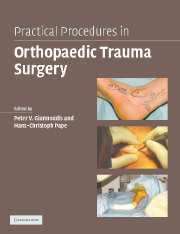16 - Reconstruction of tendons
from Chapter 16
Published online by Cambridge University Press: 05 February 2015
Summary
ACHILLES TENDON REPAIR
Indications
Controversy regarding this injury as towhethersurgical repair or cast immobilization is the most appropriate method of treatment.
Healthy, vigorous young adults.
Athletes.
According to patient's age, activities, medical history.
Pre-operative planning
Clinical assessment
Mechanism of injury: mechanical imbalance, degenerative changes, high-energy disruptions, lacerations at the posterior distal tibia aspect.
Obtain a detailed patient's history.
Usually sudden onset of pain, audible snap, patient unable to weight bear, unable to toe-raise at the affected site.
Only leg weakness in chronically ruptured tendon.
Oedema, bruising, ankle swelling.
Clinically palpable gap that may be obscured by swelling.
PerformThompson's test, O'Brien test.
Compare the affected leg with the contralateral limb.
Be alert for longstanding ruptures.
Radiological assessment
Radiographs: only to diagnose associated bony abnormalities.
High-resolution ultrasonography: produces an acoustic vacuum.
MRI: to evaluate associated intra-articular injuries and neglected tears.
Operative treatment
Anaesthesia
At induction administration of prophylactic antibiotics as per local hospital protocol.
Spinal or general anaesthesia.
Table set up
The instrumentation set is at the foot end of the table.
Patient positioning
The patient is placed in prone position.
Draping and surgical approach
Prepare the skin over lower leg, ankle and entire foot with usual antiseptic solutions (aqueous/alcoholic povidone-iodine). Prepare skin between toes thoroughly.
Apply standard draping around lower leg in calf region.
Apply tape aroundtoes tominimizethe risk of infection (Fig. 16.1).
[…]
- Type
- Chapter
- Information
- Practical Procedures in Orthopaedic Trauma Surgery , pp. 285 - 292Publisher: Cambridge University PressPrint publication year: 2006

